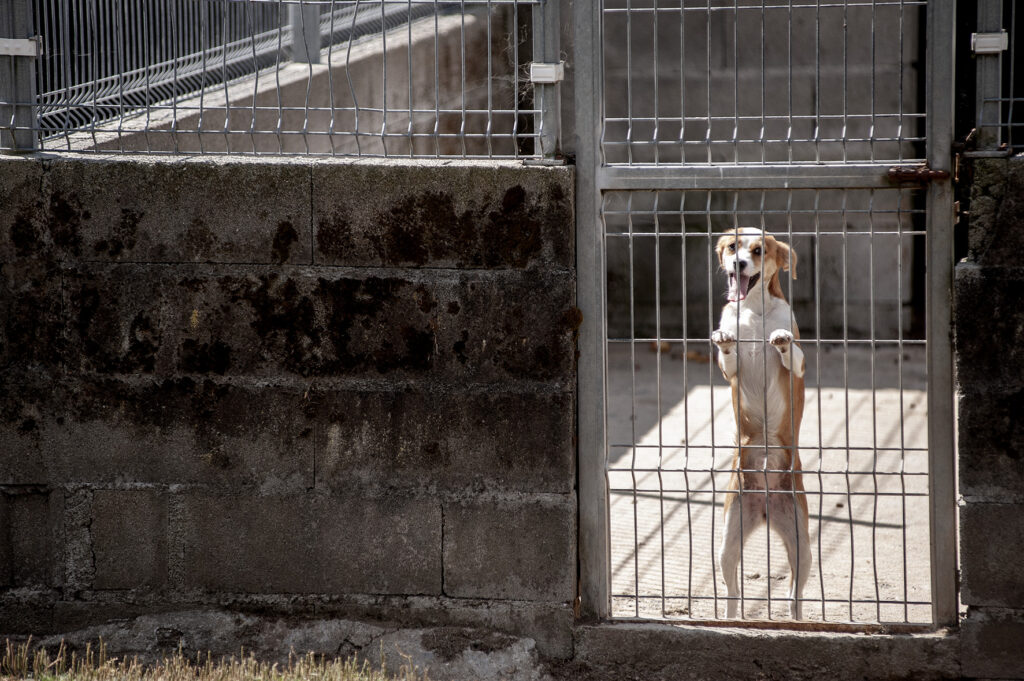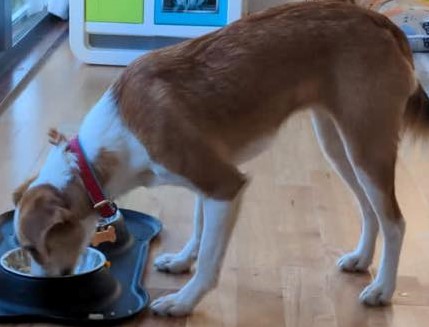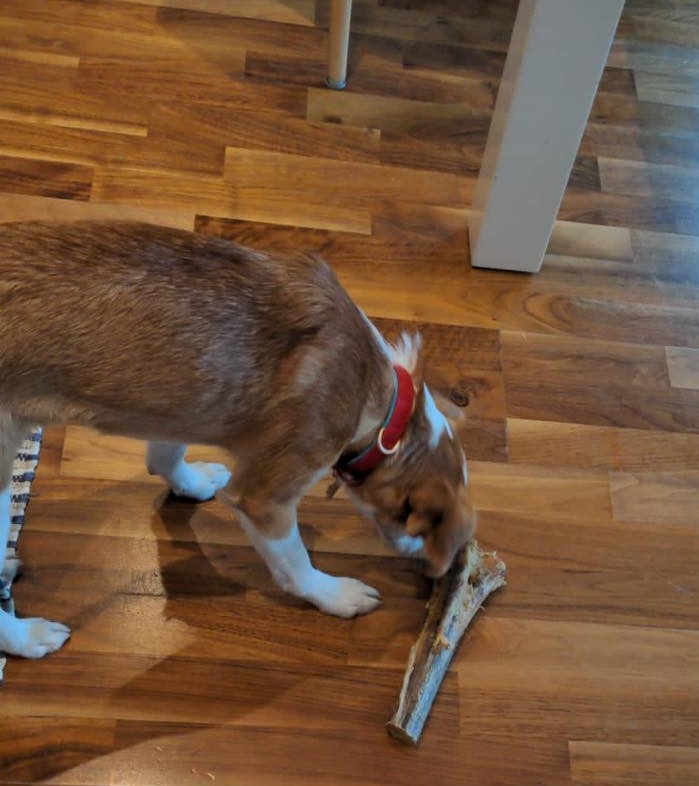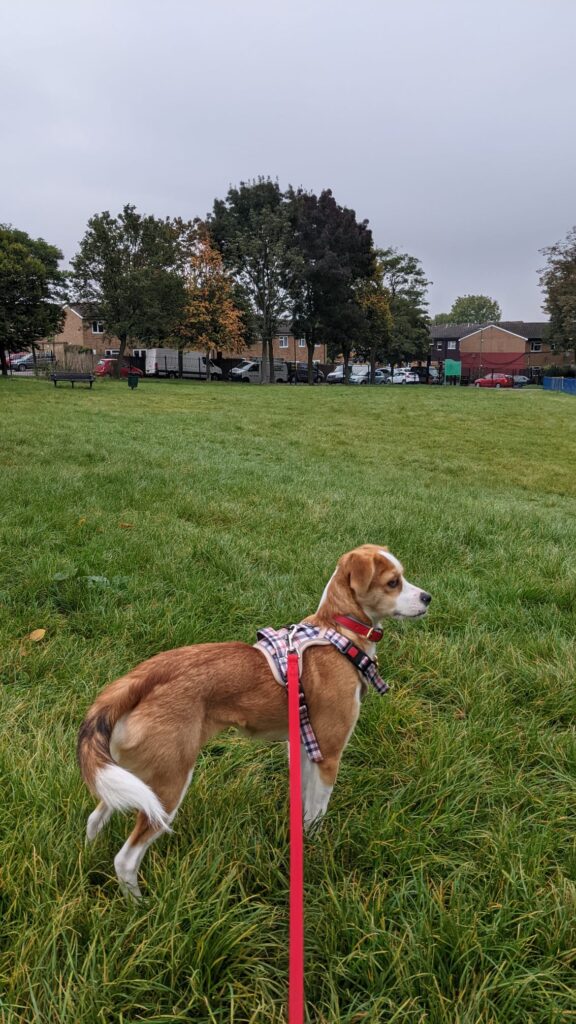Adopting your first dog is a momentous and nerve wrecking decision.
Will the dog settle, will I be a good adopter, how will I know I found the dog for me? These and many other questions will be playing in your mind.
A family in London was wrestling with these thoughts when by chance on Facebook they came across a tiny dog running like crazy at full speed from one side of a Spanish pound to the other. There amongst dogs three times her size, barking and crying, this little dog was a ball of energy and light in a place of despair. When the volunteer picked up this little dog in her arms and wrestled with the number of kisses she threw her way, this family knew that they had found her dog, thousands of kilometres away. This is how they contacted us at Five Circles Dog Rescue nervously asking if they could have her.

This initial query was followed by the completion of a pre-adopt form and a home check done via video conference, which they passed with flying colours. Videos of Peppy continued to show a dog full of energy that did not stop running. When we explained to the family if they would be willing to cope with a high-energy dog they said “she is as crazy as we are” and this is how Peppy saw herself on a late summer day arriving to her new home in the UK leaving Spain behind forever.
Peppy looked beautiful on arrival and a little sad and worried. Surely she was thinking, “What would happen to her now?”

As terrible as the pound was, she found herself in a different place, with different smells, and different people. Although she ate, drank and toilet normally on arrival, she was very quiet, focusing on her family with fierce intensity to ensure that they would not leave her behind. She did not know them very well, but she had already decided that they were good to her so she must not let them out of her sight. Her whole future depended on it.
Peppy’s thoughts and decisions were processed during this first period after adoption, which we normally refer to as the Decompression period. This is a time where upon arrival and having gone through a very extreme change in her life, her perception of the world is impaired due to high levels of stress related hormones flooding her body. Dog’s high stress levels and anxiety can manifest in a multitude of ways.
After a few days, it was obvious that Peppy could not cope with being left alone for any length of time. Each time her new parents tried to leave her alone, she would howl, bark and become very distressed through the cameras that were recording her movements on her adopter’s absence.
Peppy was suffering from separation anxiety
Separation anxiety is a very common condition by which the dog panics when left alone. It does need to be taken seriously. The dog sees the adopters as their source of safety, and without them, their wold falls apart. Therefore, it is important that these dogs are never left alone until the Separation Anxiety is cured.
The first step was to give Peppy some time to relax without changes allowing her to progress further through the decompression period and give her time for her stress hormones to reduce. Usually this takes place around the three weeks for most dogs on average. After three weeks and once Peppy become more relaxed, her adopters could then start working to help her feel less anxious when alone. They best way to do this was by applying a protocol whose aim was to desensitise her to being alone and then counter conditioned her. In summary, to ensure that her feelings when left alone were not just negative but as positive as possible to ensure that her sense of panic would disappear to be replaced by one of contentment.
How can we do that? It is important that protocols for separation anxiety are applied by a knowledgeable behaviourist, who can take into account the personality and living conditions of the dogs. The protocols will be modified along the way to fit each dog and therefore get maximum results.
An important task for adopters upon arrival of a newly adopted dog is to identify what the dog likes most, that could be food or a toy, but it needs to be something that is very valuable for the dog.

Dogs learn by Operating Conditioning, which is by action and consequence. If they do something and there is a positive consequence, for example, they get a tasty treat, then they are more inclined to do it again in the hope that another tasty treat will come their way. After many repetitions, the dog will learn to do it without a treat and the nice feelings of having a treat forever associated with the action. On the reverse if, your dogs’ action does not get a positive consequence, they will be less inclined to exhibit this behaviour over time. Hence, you must always ignore bad behaviour. Raymond and Lorna Coppinger in their book “Dogs a new Understanding of Canine origin, Behaviour and Evolution” state that there is no other animal better than dogs at learning by Operating Conditioning methods.
Dogs are the champions at this and can be taught nearly anything using this method.
Peppy’s adopters identified what she liked most, a tasty Ostridge bone, and then they ensured that Peppy would get this treat whenever she was alone with her adopters initially outside of the room, then further down the corridor and then fully outside the house.. It was important that during the time that Peppy was alone, not just nothing bad happened, but that she had something really nice which she loved and that was chewing on her Ostridge bone.

It is a slow process that may take many days and weeks, with some periods of improvement and some periods where it may worsen again, but little by little, Peppy’s attention will be more and more focused on the treats than in their parent’s absence. Suddenly having your adopters leave the house will not be so bad after all and after a while, she may rejoice at the prospect because she knows that that is the time for her to have her much cherished bone. A long way from the feeling of desperation and despair she used to feel during the first few times. With time, those feelings of contentment on her adopter’s absence will still be there even if a bone is not on hand to chew. The dog has been counter conditioned.

Jennifer Titus in her website for Care for Reactive Dogs explains:
“We can change a dog’s emotional response to triggers by repeatedly pairing the trigger with something the dog enjoys, such as food, toys or play. In time, the dog learns to associate the trigger with the pleasurable thing, and develops a positive conditioned emotional response to the trigger itself”.
Most importantly, Lovely Peppy is becoming happier and happier when alone for short amount of times and with time and patience the length of time that she will bear being alone will continue to extend.
It is important to understand that changes in your dog’s behaviour will happen slowly and any protocol will need to be continually changed and adapted to get the best results. This is always better done with the support and leading hand of a professionally qualified behaviourist. Always look for IMDT or APDT qualifications.
If your dog has any issue on arrival, always ask for help from a seasoned and experienced behaviourist. Moreover, remember that it is never too late to teach your dog to enjoy a bit of solitude and alone time.



